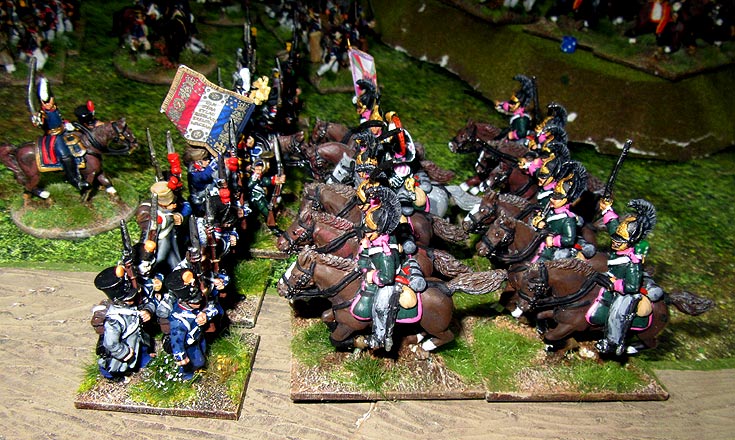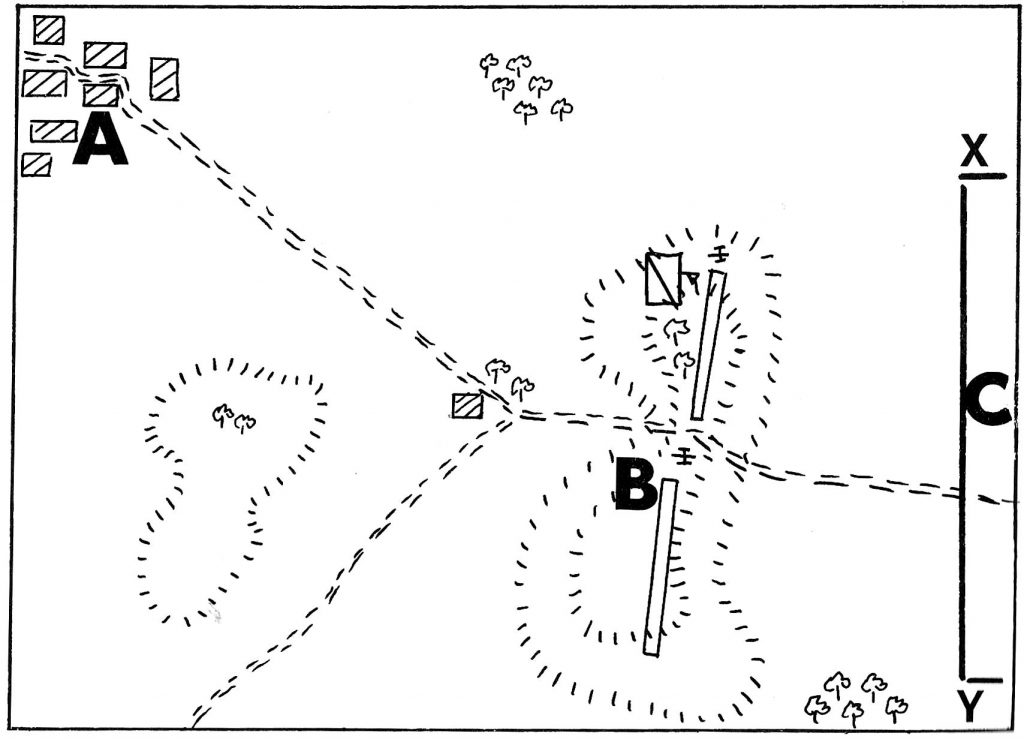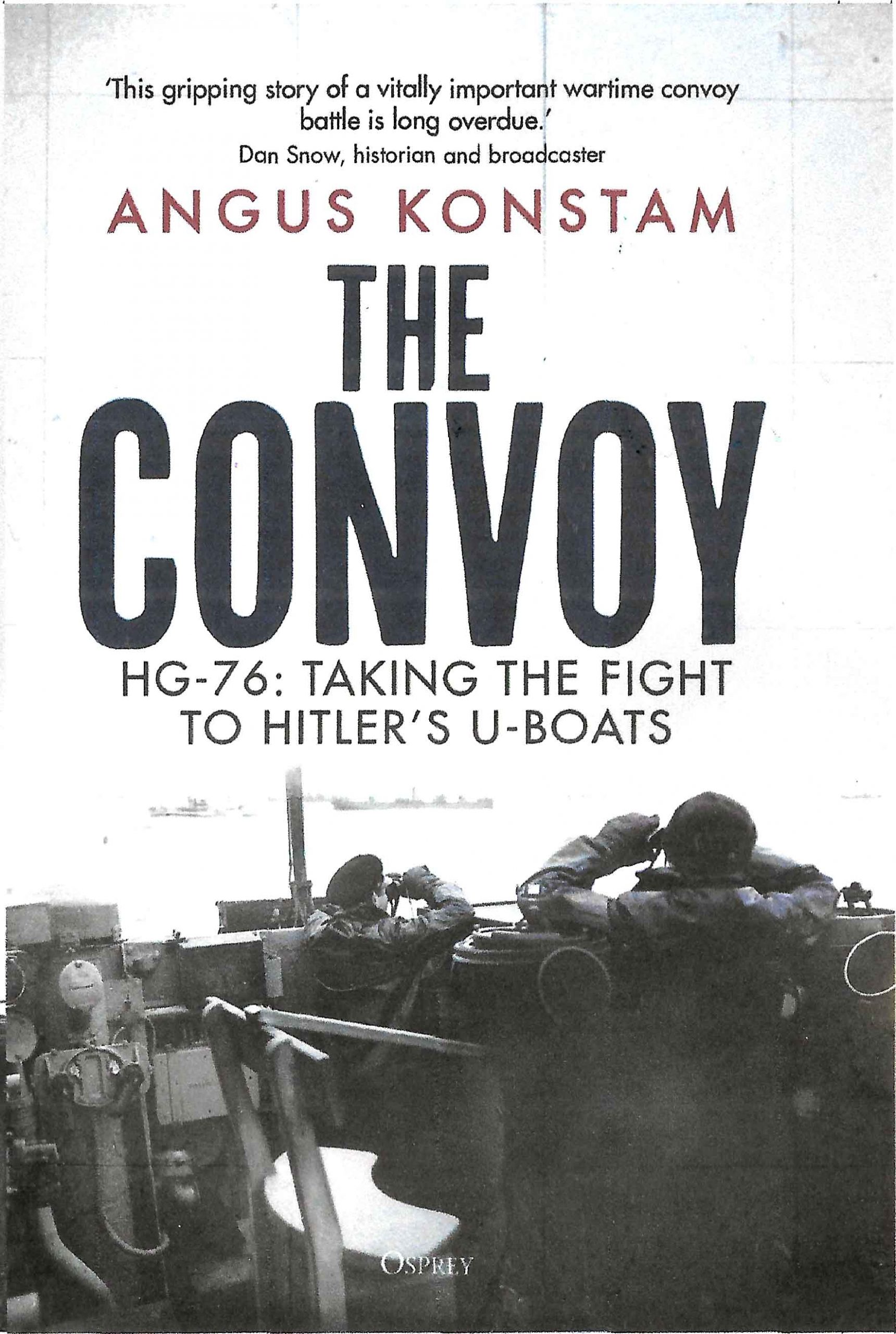
The Falkenügel, 1813
14th November 2024, 2 Comments
The Napoleonic Wars, Shadow of the Eagles, 28mm
This was a scenario lifted straight from by friend Charles S. Grant’s Scenarios for Wargames (1981), a standard ‘go-to’ for fiendish tabletop challenges. This one was certainly a challenge – a small blocking force, deployed on a hill, buying time for reinforcements to arrive. Even then the defenders were outnumbered. In this game, set in Napoleon’s Spring Campaign of 1813, Sean attacked with his French, while my Allies had the task of holding the hill.  The game began with a small Russian brigade deployed at B – two musketeer battalions and a heavy gun battery, with a regiment of dragoons in reserve. The French appeared at C on Turn 1, between X and Y, with a strong divisional force made up of eight infantry battalions, a light infantry battalion, three regiments of cavalry and two batteries of guns.
The game began with a small Russian brigade deployed at B – two musketeer battalions and a heavy gun battery, with a regiment of dragoons in reserve. The French appeared at C on Turn 1, between X and Y, with a strong divisional force made up of eight infantry battalions, a light infantry battalion, three regiments of cavalry and two batteries of guns. That’s the Russians holding the Falkenügel above, facing west, just in front of the village of Aschersleben, a few miles south of Magdeburg. The French appeared from the western (short) table edge of the 6×4 foot table. The Prussian reinforcements came on at B; four musketeer battalions, a light battalion, a cavalry regiment, and had to negotiate the mean streets of Aschersleben before they could deploy.
That’s the Russians holding the Falkenügel above, facing west, just in front of the village of Aschersleben, a few miles south of Magdeburg. The French appeared from the western (short) table edge of the 6×4 foot table. The Prussian reinforcements came on at B; four musketeer battalions, a light battalion, a cavalry regiment, and had to negotiate the mean streets of Aschersleben before they could deploy.  Sean committed his troops to the assault from the very start. Unusually, his infantry deployed into line when they entered the table, while the guns deployed on their right. Beyond them, on the French right flank, the cavalry entered the table, but stayed in squadron columns, for better maneuverability. I soon learned why, as Sean’s 20th Dragoons, turned right, then launched a charge into the flank of the left-hand Russian infantry battalion.
Sean committed his troops to the assault from the very start. Unusually, his infantry deployed into line when they entered the table, while the guns deployed on their right. Beyond them, on the French right flank, the cavalry entered the table, but stayed in squadron columns, for better maneuverability. I soon learned why, as Sean’s 20th Dragoons, turned right, then launched a charge into the flank of the left-hand Russian infantry battalion.  This wasn’t good. I tried to form ’emergency square’, but failed – it was only half-formed when the horsemen struck. The French had the odds in their favour, especially with General de Brigade Seron leading the charge, and after three turns of fighting my battalion from the Butyrsk regt. was ridden down. Sean wasn’t done though, as he continued into my guns, beyond the collapsed square. Here the crew just had time to evade before the guns were lost.
This wasn’t good. I tried to form ’emergency square’, but failed – it was only half-formed when the horsemen struck. The French had the odds in their favour, especially with General de Brigade Seron leading the charge, and after three turns of fighting my battalion from the Butyrsk regt. was ridden down. Sean wasn’t done though, as he continued into my guns, beyond the collapsed square. Here the crew just had time to evade before the guns were lost.  So, things weren’t going well… The Prussians were still negotiating the bottleneck of the village, and so were a long way short of lending a hand. It all took time – too much time – to sort out, and meanwhile the French were running amok on the Falkenügel… and it was still only the end of Turn 2! The French won the initiative, and inevitably Sean led with the 20th Dragoons, who hit the flank of my remaining Russian infantry battalion of the Shirvan regt.
So, things weren’t going well… The Prussians were still negotiating the bottleneck of the village, and so were a long way short of lending a hand. It all took time – too much time – to sort out, and meanwhile the French were running amok on the Falkenügel… and it was still only the end of Turn 2! The French won the initiative, and inevitably Sean led with the 20th Dragoons, who hit the flank of my remaining Russian infantry battalion of the Shirvan regt. This time though, the French didn’t have it all their own way. Although after two rounds I was forced off the hill, Gen. Tsybulky’s presence was enough to prevent a rout, and the battalion fell back in order, while the now weakened French dragoon regiment paused to draw breath. Fortunately, the Prussians were now coming on, led by Col. von Mutius and the Neumark Dragoons. In fact, it was their arrival that helped stem the French tide.
This time though, the French didn’t have it all their own way. Although after two rounds I was forced off the hill, Gen. Tsybulky’s presence was enough to prevent a rout, and the battalion fell back in order, while the now weakened French dragoon regiment paused to draw breath. Fortunately, the Prussians were now coming on, led by Col. von Mutius and the Neumark Dragoons. In fact, it was their arrival that helped stem the French tide.  The Prussian Neumark Dragoons were joined by the Russian Smolensk Dragoons, who led the way by charging into the French 16th Chasseurs-a-Cheval. The French were broken, and so the victorious Russian horse pursued into the French light infantry battalion, which were behind the chasseurs. This time the light infantry also failed to form emergency square, and were ridden down as they stood. Things were starting to look a little better for the Allies…
The Prussian Neumark Dragoons were joined by the Russian Smolensk Dragoons, who led the way by charging into the French 16th Chasseurs-a-Cheval. The French were broken, and so the victorious Russian horse pursued into the French light infantry battalion, which were behind the chasseurs. This time the light infantry also failed to form emergency square, and were ridden down as they stood. Things were starting to look a little better for the Allies… The French weren’t done though. Up on the hill the 7th Hussars had seen the charge play out below them, and they promptly charged down the hill and into the rear of the Russian dragoons., Not to be outdone the Prussian Neumark dragoons charged into the back of the French hussars. this was one that had us scrambling for the rule book, but it worked out that the Smolensk regt. was weakened, and the 7th Hussars were broken and routed.
The French weren’t done though. Up on the hill the 7th Hussars had seen the charge play out below them, and they promptly charged down the hill and into the rear of the Russian dragoons., Not to be outdone the Prussian Neumark dragoons charged into the back of the French hussars. this was one that had us scrambling for the rule book, but it worked out that the Smolensk regt. was weakened, and the 7th Hussars were broken and routed.  This was all very well, but it still hadn’t helped me recapture the Falkenügel. The Prussian infantry were coming on in assault columns, while the leading French holding the hill were now in line. This was going to be a tough fight, and we were running out of gaming time. Still, I was determined to have a go, and so my two leading 1st Silesian musketeer battalions switched into line, and began a firefight, while the rest of the Prussian battalions came up in support. My cavalry though, weren’t much use, as they were all recovering from disorder, while keeping out of canister range of the French guns.
This was all very well, but it still hadn’t helped me recapture the Falkenügel. The Prussian infantry were coming on in assault columns, while the leading French holding the hill were now in line. This was going to be a tough fight, and we were running out of gaming time. Still, I was determined to have a go, and so my two leading 1st Silesian musketeer battalions switched into line, and began a firefight, while the rest of the Prussian battalions came up in support. My cavalry though, weren’t much use, as they were all recovering from disorder, while keeping out of canister range of the French guns. My excuse is that we ran out of time – as it was past 9.30pm, and had to head home. In truth though, Sean now held the hill in strength, and I lacked the muscle to take it back from him. The loss tally was marginally in the Allied favour, but the key objective was the Falkenügel, which remained firmly in French hands. So, this was a French victory, and Sean’s second win over me in two weeks! Still, we both thoroughly enjoyed the challenging wee game!
My excuse is that we ran out of time – as it was past 9.30pm, and had to head home. In truth though, Sean now held the hill in strength, and I lacked the muscle to take it back from him. The loss tally was marginally in the Allied favour, but the key objective was the Falkenügel, which remained firmly in French hands. So, this was a French victory, and Sean’s second win over me in two weeks! Still, we both thoroughly enjoyed the challenging wee game!


That was indeed a tough challenge for the defenders. And then to get flanked so early too.
Good to see the French win though. 🙂
Never played that rules set, your opinion on it?
My timing was off, Joseph. The temptation to maximise firepower for as long as possible puts you at risk from cavalry charges.
The ties work well,and as they’re the Napoleonic version of Honours of War, our preferred SYW set, then they’re easy to remember.